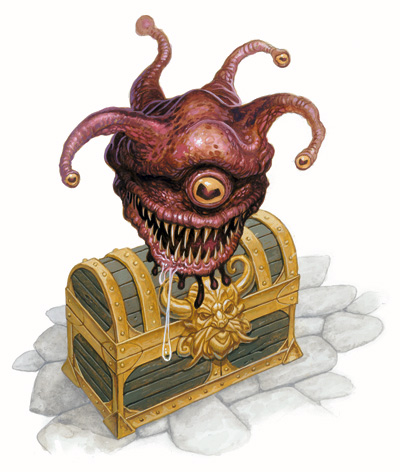

FREQUENCY: Very rare
FREQUENCY: Very rare ([Dungeon
Level IV])
NO. APPEARING: 1-2
ARMOR CLASS: Body 4, eyes
7
MOVE: 10" (MC: B)
HIT DICE: 4+4
% IN LAIR: 100%
TREASURE TYPE: [See below]
NO. OF ATTACKS: 1
DAMAGE/ATTACK: 1
SPECIAL ATTACKS: [SB]
SPECIAL DEFENSES: [SB]
MAGIC RESISTANCE: 5%
INTELLIGENCE: Very to high
ALIGNMENT: Lawful neutral
SIZE: L (4' diameter)
LEVEL/X.P. VALUE: V | 350
+ 9
The spectator is a guardian
of places and treasures. Once it is given a
task it will guard for up
to 101 years and will let no one use, borrow, or
examine an item or treasure.The
treasure being guarded is 90% likely to
be a magic
item or have a value of at least 15,000 gp. If the spectator
gains incidental treasure
while performing its duty, this will not trouble
its conscience and the treasure
may be taken freely. Incidental treasure
can amount to the following
sums: 40% for 3-300 coins of mixed types
(1 -20 platinum, 2-40 gold,
4-80 electrum, and the balance, if any, will be
silver); 30% for 1-6 gems
of base value 50 gp; 20% for 1-4 potions; 15%
for a +1 piece of
armor; 15% for a +1 weapon;
and 5% for a miscellaneous
magic item valued under 10,000 gp.
Spectators are summoned from
Nirvana
by monster summoning V and
the sacrifice of 3 small
eyes (or more) from a beholder. The spectator can
be commanded only to guard
some treasure. It will perform no other
duty, and if commanded in
some other way it will return to Nirvana
immediately. If its guarded
item(s) is ever destroyed or successfully
stolen the spectator is
released from service and may return to Nirvana.
The summoner, of course,
may take the item himself and thus release
the spectator.
The spectator has a large
central eye and 4 smaller eye stalks protruding
from the top of its spherical
body. The body surface is covered in tough
hide and thus is armor class
4. Any general blow is 70% likely to hit the
body. The body contains
all of the beastís hit points. Hits on the eye
stalks (AC 7) or the central
eye (also AC 7) will occur 30% of the time
(divided up as 20% for the
eye stalks, 10% for the central eye). Any such
hit destroys the eye. A
spectator blinded in every eye cannot defend its
treasure and will teleport
to Nirvana. This is the only condition under
which it will leave its
post. Its eyes regenerate in 1 day and then it will
return. If the treasure
is gone the creature will return to Nirvana.
The beast has a general magic
resistance of 5%. However, when the
central eye is undamaged,
it can reflect 1 spell fired at it per round and
turn the spell back to the
caster. This does not apply to touch spells of
any kind. The reflection
occurs only if the spectator makes a saving
throw vs. spells. For example,
if a magic-user casts a lightning bolt at a
spectator, the spectator
rolls a saving throw to see if the spell is
reflected, and if it is
not then it rolls for its magic resistance percentage.
If this also fails, the
lightning bolt does damage. The spell caster is
allowed a normal saving
throw vs. the reflected spell in all cases and
only he or she must suffer
any damage. Thus, in the above example, if
the lightning bolt were
reflected, onlythe magic-user could be hit by it,
even if a familiar were
sitting on the magic-userís shoulder. If the
magic-user makes the saving
throw, he or she takes no damage what-
soever! Reflection is possible
only if the spell caster is standing in front
of the central eye within
the space of a 60 degree arc. Range is not a
factor, since getting the
spell to the spectator is the onlyconsideration.
The central eye can only
reflect 1 spell per round, even if 2 spells arrive
in the same segment. These
small eyes act by glance and are thus very
fast. The other eyes have
magical powers as follows:
Eye 1:
Create food and water. Obviously this is not an attack.
Eye 2:
Cause serious wounds. Inflicts 2d8+3 damage vs. a single
figure
at a range of 60 feet. A saving throw vs. spells is
allowed
and, if successful, only half-damage is sustained.
Eye 3:
Paralyzation ray. Range of 90 feet, one target only, duration
5-20
rounds. The spectator never attacks a paralyzed
character
or uses him or her for food. A paralyzed character
might
be allowed to go its own way if it is willing to
leave
in peace.
Eye 4:
Telepathy. Range 120 feet, 1 target only. Communication
is possible
in this way. The beast can also implant a suggestion
if the
target fails to make a saving throw. This
suggestion
is always to leave in peace.
Initiative for the spectator
is made rolling a 1 d8 instead of a 1 d6 in all
cases. All three "attack
eyes" can be brought into play. Causing wounds
or paralyzation takes only
1 segment, as does the suggestion to leave in
peace. Communication takes
2 segments. Creating the amount of food
and water for a large meal
(up to 6 persons) takes 1 full round.
The spectator can sense psionic
disciplines, powers, and spell-like
effects at a range of 240
feet, even through wood, although not through
metal or stone. Thus, the
spectator is difficult to surprise (only on a 1 on a 1d12).
The spectator, being basically
passive, will attempt to communicate
and implant its suggestion
as its first act unless it is immediately
attacked. In close combat
the spectator can bite for 2-5 points of
damage.
If properly confronted, the
spectator can be quite friendly. It will tell a
party exactly what it is
guarding early in any conversation so that there
will be no argument! If
its charge is not threatened it can be quite
amiable and even talkative
via telepathy.
Spectators move by a very
rapid levitation in any direction. They will drift
aimlessly when asleep (20%
likely when encountered), never touching
the ground.
